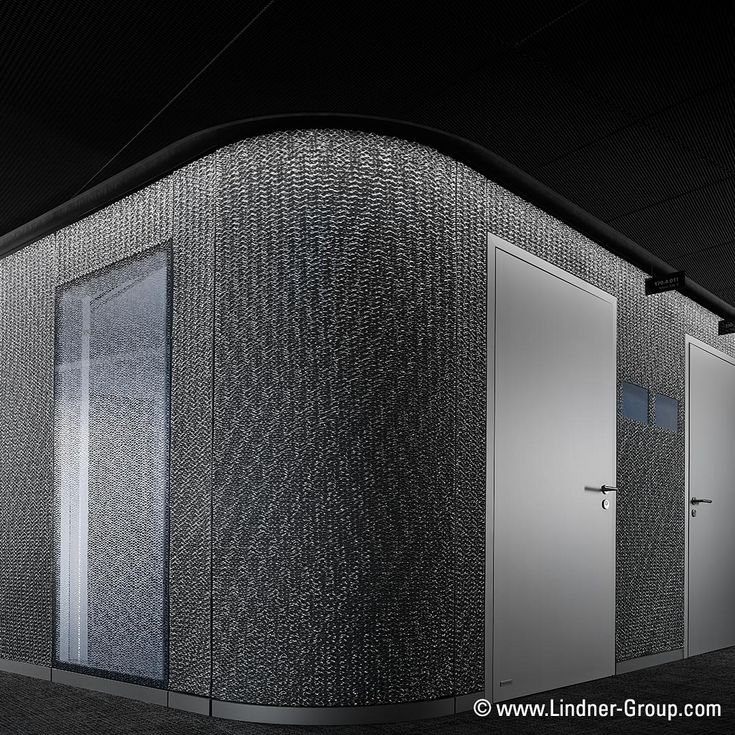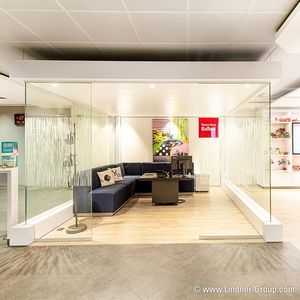
Builtworld: Raum-in-Raum Systeme als Produktionshelfer in neuen Arbeitswelten
Fertigstellung am 07.06.2022, Veranstaltungen
von Redaktion baupause.de
Vor kurzem fand ein von Builtworld veranstaltetes Online Event zum Thema „Raum-in-Raum Systeme als Produktionshelfer in neuen Arbeitswelten“ statt. Mit dabei waren Gregor Kamps von Lindner, Dr. Alexandra Heinzelmann von Hallo Arbeit und Prof. Dr. Sabine Wölflick von der Hochschule München. // An online event organised by Builtworld recently took place on the topic of "Room-in-Room Systems as Production Assistants in New Working Worlds". Participants were Gregor Kamps from Lindner, Dr Alexandra Heinzelmann from Hallo Arbeit and Prof Dr Sabine Wölflick from Munich University of Applied Sciences.
Die Veranstaltung fand am 18. Mai von 8.00 bis 9.00 Uhr online statt. Moderiert wurde das Gespräch von Wolfgang Moderegger, Moderator bei Builtworld. Knapp 200 Menschen aus unterschiedlichen Branchen und Interessengebieten haben teilgenommen.
Zu Beginn des Online Panels stellten sich alle Gesprächsteilnehmer kurz vor. Dabei ging Gregor Kamps insbesondere auf die Frage ein, warum sich ein Spezialist für Innenausbau wie Lindner in den letzten Jahren zunehmend mit innovativen Workspace-Lösungen beschäftigt: Im Fokus stand bei Lindner immer der Kunde ‒ als dieser zunehmend nach neuen Arbeitswelten fragte, schaffte Lindner die Verbindung zwischen Innenausbau und Workspace.
Im Laufe der Veranstaltung kam vor allem das „Post-Corona-Office“ zu Gespräch. Insbesondere die Pandemie hat einen Wandel der Arbeitswelten angestoßen: Das Büro wird auf einmal hinterfragt, die Home-Office Quoten steigen und ein Remote-Work-Angebot wird bei der Jobsuche oftmals vorausgesetzt. Das bedeutet allerdings nicht, dass das Büro nicht mehr gebraucht wird, sondern lediglich, dass Arbeitsumgebungen anders gestaltet werden müssen. Prof. Dr. Sabine Wölflick hat dazu Interviews mit drei Zielgruppen aus unterschiedlichen Altersgruppen der Lindner Group geführt. Das Ergebnis: Die Befragten hatten völlig unterschiedliche Bedürfnisse in Bezug auf die Gestaltung ihrer Arbeitswelten.
Dr. Alexandra Heinzelmann ergänzte, dass sich vor allem die innere Haltung der Arbeitnehmer verändert hat: „Arbeit wird zum Lifestyle“. Ziel ist es daher, in Unternehmen sowohl Orte für Kommunikation als auch für Konzentration zu schaffen. Ganz nach dem Motto „New Work meets Inner Work“ betonte sie, dass Arbeitsplätze individuell nach den Bedürfnissen der Mitarbeiter gestaltet werden müssen. Prof. Dr. Sabine Wölflick gibt hierzu den Tipp „Lernt eure Zielgruppe kennen! Was denken und fühlen sie?“. Unternehmen wie Lindner haben dann die Aufgabe, diese Wünsche umzusetzen. Gregor Kamps erklärt, wie das gelingt: Im Zuge des Wandels der Arbeitswelt entstehen neue Produkte. Dabei setzt Lindner in erster Linie auf standardisierte Individualisierung, das heißt, Produkte sehen auf den ersten Blick gleich aus, haben aber vollkommen unterschiedliche Funktionen und können so verschiedene Bedürfnisse erfüllen.
Im Folgenden zeigte Moderator Wolfgang Moderegger einige Bilder von verschiedenen Lindner Raum-in-Raum Systemen im Einsatz. Mit dabei waren die „Filiale der Zukunft“ bei der Haspa Hamburg, der Cube Open, das Klubhaus Swiss Zürich sowie der Raum-in-Raum in Kombination mit gebogenem Streckmetall bei KPMG Zürich. Gregor Kamps betonte die Vielfältigkeit der Raum-in-Raum Systeme ‒ während das System bei KPMG höchste Vertraulichkeit ermöglicht, sind das Klubhaus Swiss sowie der Cube Open eher Orte für schnelle, unkomplizierte Gespräche mit einer sogenannten „offenen Privatheit“.
Im Zuge der veränderten Arbeitsbedingungen hat sich auch die Rolle des Designers verändert: Früher galt der Designer als eine Art „Vordenker“, der versucht hat, für den Kunden bestmögliche Lösungen zu gestalten und zu entwickeln. Heute wollen Mitarbeiter ihre Arbeitsplätze selbst gestalten – der Designer hingegen muss den Kunden zuhören und dann verwirklichen, was sie haben möchten. Aufgabe des Designers ist es somit, die Wünsche des Kunden in die Realität umzusetzen. Partizipation spielt daher eine viel größere Rolle als noch vor einigen Jahren.
Weiterhin startete Wolfgang Moderegger eine Umfrage für die Zuschauer mit der Frage „Was ist für Sie bei Raum-in-Raum Systemen am wichtigsten?“. Die Ergebnisse zeigten, dass vor allem Akustik, Luft, Licht und Klima sowie das „Gefühl des Nicht-gestört-werdens“ eine große Rolle spielen. Ziel der Lindner Group ist es daher, neue Lösungen zu entwickeln, die all diese Bedürfnisse erfüllen, die man als Nutzer aber noch nicht im Kopf hat. Auch bei der Entwicklung des Lindner FlexShells orientierte man sich an den Wünschen der Nutzer und versuchte, diese bestmöglich umzusetzen. Daher enthält der FlexShell eine Glasscheibe für Hygiene und Akustik, einen Vorhang für Ruhe und einen bodengleichen Zugang. Der Nutzer kann das System schließlich so anpassen, wie er es gerade haben möchte.
Gregor Kamps schloss das Gespräch damit, dass Lindner nicht das Ziel des Consultings verfolge, sondern eher neue Lösungen aufzeigen möchte. Die Transformation von den Kundenbedürfnissen zu den fertigen Lösungen geschehe dabei häufig mittels Workshops.
Sie haben die Veranstaltung leider verpasst, möchten aber trotzdem mehr erfahren? Die Paneldiskussion in voller Länge gibt es hier: https://www.builtworld.com/event/raum-in-raum-systeme-produktion-neue-arbeitswelten
Builtworld: Room-in-Room Systems as Production Assistants in New Working Environments
An online event organised by Builtworld recently took place on the topic of "Room-in-Room Systems as Production Assistants in New Working Worlds". Participants were Gregor Kamps from Lindner, Dr Alexandra Heinzelmann from Hallo Arbeit and Prof Dr Sabine Wölflick from Munich University of Applied Sciences.
The event took place online on 18 May from 8.00 to 9.00 am. The discussion was moderated by Wolfgang Moderegger, moderator at Builtworld. Almost 200 people from different sectors and areas of interest took part.
At the beginning of the online panel, all participants introduced themselves briefly. In particular, Gregor Kamps addressed the question of why a specialist in interior fit-out such as Lindner has been increasingly involved with innovative workspace solutions in recent years: Lindner's focus has always been on the customer – when the customer increasingly asked for new working worlds, Lindner created the connection between interior fit-out and workspace.
During the event, the "post-Corona office" came up for discussion. The pandemic in particular has triggered a change in working worlds: The office is suddenly being questioned, home office quotas are rising and a remote work offer is often a prerequisite when looking for a job. However, this does not mean that the office is no longer needed, but merely that working environments have to be designed differently. Prof Dr Sabine Wölflick conducted interviews with three target groups from different age groups at the Lindner Group. The result: the interviewees had completely different needs with regard to the design of their working environments.
Dr Alexandra Heinzelmann added that above all the inner attitude of employees has changed: "Work is becoming a lifestyle". The goal is therefore to create places in companies for both communication and concentration. In keeping with the motto "New Work meets Inner Work", she emphasised that workplaces must be designed individually according to the needs of the employees. Prof Dr Sabine Wölflick gives the tip: "Get to know your target group! What do they think and feel?" Companies like Lindner then have the task of implementing these wishes. Gregor Kamps explains how this can be done: In the process of changing the world of work, new products are being created. Lindner primarily relies on standardised individualisation, which means that products look the same at first glance, but have completely different functions and can thus fulfil different needs.
In the following, moderator Wolfgang Moderegger showed some pictures of various Lindner room-in-room systems in use. These included the "branch of the future" at Haspa Hamburg, the Cube Open, the Klubhaus Swiss Zurich and the room-in-room in combination with curved expanded metal at KPMG Zurich. Gregor Kamps emphasised the diversity of the Room-in-Room systems – while the system at KPMG allows highest levels of confidentiality, the Klubhaus Swiss as well as the Cube Open are rather places for quick, uncomplicated conversations with a so-called "open privacy".
As working conditions have changed, the role of the designer has also changed: In the past, the designer was considered a kind of "mastermind" who tried to design and develop the best possible solutions for the client. Today, employees want to design their workplaces themselves – the designer, on the other hand, has to listen to the customers and then realise what they want. The designer's task is therefore to turn the customer's wishes into reality. Participation therefore plays a much greater role than it did a few years ago.
Furthermore, Wolfgang Moderegger launched a survey for the audience with the question "What is most important to you in room-in-room systems?" The results showed that above all acoustics, air, light and climate as well as the "feeling of not being disturbed" play a major role. The Lindner Group's goal is therefore to develop new solutions that meet all these needs, but which users do not yet have in mind. The development of the Lindner FlexShell was also oriented towards the wishes of the users and tried to implement them in the best possible way. Thus, the FlexShell contains a glass pane for hygiene and acoustics, a curtain for quietness and a floor-level access. In the end, the user can customise the system just the way he or she wants it.
Gregor Kamps concluded the talk by saying that Lindner's goal is not to consult, but rather to demonstrate new solutions. The transformation from the customer's needs to the finished solutions often happens by means of workshops.
You unfortunately missed the event but would still like to learn more? The panel discussion in full length is available here: https://www.builtworld.com/event/raum-in-raum-systeme-produktion-neue-arbeitswelten

